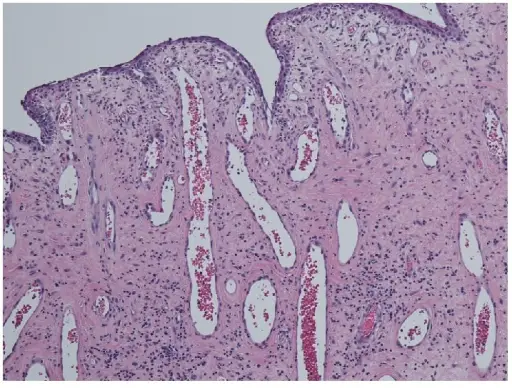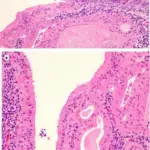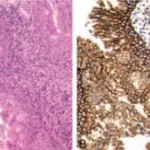Nasopharyngeal angiofibroma is a peculiar tumor that occurs entirely in adolescent males (10-20 years of age) suggesting the role of testosterone hormone in its production.
What is the Pathology of Nasopharyngeal Angiofibroma?
The pathology of nasopharyngeal angiofibroma is:
-Etiology: The cause of nasopharyngeal angiofibroma is hormonal theory testosterone proposed and also suggested nonchromaffin paraganglionic cells.
-Genes involved: adenomatous polyposis coli (APC) gene.
-Pathogenesis: The sequence of events that lead to nasopharyngeal angiofibroma is: Starts next to the sphenopalatine foramen. Frontal growth occurs beneath the nasopharyngeal mucous membrane, relocating it anteriorly, inferiorly to the postnasal space. Nasal cavity filled on one side deviating septum to the other side.
-Histology: The histology associated with nasopharyngeal angiofibroma shows numerous small endothelium-lined vascular spaces and the stromal cells which are myofibroblasts.
How does Nasopharyngeal Angiofibroma Present?
Patients with nasopharyngeal angiofibroma typically affect young males present at age range of 10-28years. The symptoms, features, and clinical findings associated with nasopharyngeal angiofibroma include proptosis, orbital mass, nasal obstruction, facial swelling, epistaxis, and nasal mass.
How is Nasopharyngeal Angiofibroma Diagnosed?
Nasopharyngeal angiofibroma is diagnosed through Plain radiography views of the sinuses, Magnetic resonance imaging (MRI), and CT scan.
How is Nasopharyngeal Angiofibroma Treated?
Nasopharyngeal angiofibroma is treated through medical therapy hormonal therapy or surgery.
What is the Prognosis of Nasopharyngeal Angiofibroma?
The prognosis of nasopharyngeal angiofibroma is good under proper management.



